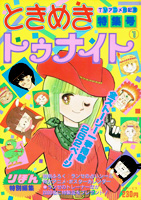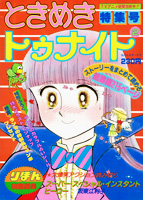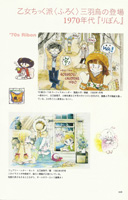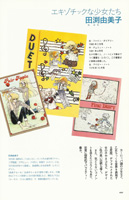about Tokimeki Tonight
Tokimeki Tonight was serialized in the shōjo manga magazine Ribon between 1982 and 1994, with a concluding chapter being published in 1999. It's a comedic fantasy epic about three generations of heroines: Etō Ranze, the daughter of a werewolf and a vampire; Ichihashi Narumi, the girlfriend of Ranze's brother Rinze; and Aira, Ranze's daughter.
-


- Anime special issues from 1982 and 1983
The manga is notable for being created with the purpose of "media mix", i.e. it was already decided before the start of the series that a TV anime version would be produced and broadcast along with the manga. (This is also how Sailor Moon originally came to be.) The anime ran for a year and 34 episodes while the manga became so successful that it continued long after the conclusion of the anime, remaining one of the top series in Ribon for its decade-long run.
Shueisha has announced that the manga has sold more than 30 million copies by 2018, making it one of the top-selling, most beloved shōjo manga in history.
Please see below for more historical information about the series, and the individual pages for the heroines (Ranze, Narumi, and Aira) for details about plot and characters. The rest of the site deals with the various biproducts to the series, such as the anime, a fanbook, an anniversary exhibition, various spin-offs and sequels, and much more, and also contains a large collection of color pages and furoku art among other things.
Timeline
The history of Tokimeki Tonight spans several decades, and side stories and sequels continue to be published to this day.
mm.yyyy |
Event |
| 06.1982 | Tokimeki Tonight begins serialization in Ribon (July issue), with what would later become known as the Ranze arc |
| 10.1982 | Tokimeki Tonight anime begins airing on Nippon Television |
| 09.1983 | The anime ends with 34 episodes broadcast |
| 04.1987 | Ranze arc concludes (May issue) |
| 08.1987 | A side story featuring Ranze is published in Ribon (September issue) |
| 11.1987 | A side story featuring Ranze is published in Ribon (December issue) |
| 01.1988 | Serialization of the Narumi arc begins in Ribon (February issue) |
| 05.1990 | Narumi arc concludes (June issue) |
| 07.1990 | First part of Futaba side story is published in Ribon (August issue) |
| 08.1990 | Futaba side story concludes (September issue) |
| 12.1990 | Heroine ni naritai begins serialization in Ribon (January 1991 issue) |
| 02.1991 | Heroine ni naritai concludes (March issue) |
| 06.1991 | Serialization of the Aira arc begins in Ribon (July issue) |
| 09.1994 | Aira arc concludes (October issue) |
| 12.1994 | Nurse Angel Ririka SOS begins serialization in Ribon (January 1995 issue) |
| 07.1995 | Nurse Angel Ririka SOS anime begins airing on TV Tokyo |
| 03.1996 | Nurse Angel Ririka SOS anime ends with 35 episodes broadcast |
| 05.1996 | Nurse Angel Ririka SOS manga concludes (July issue) |
| 11.1996 | Oshiete Nanoka begins serialization in Ribon (December issue) |
| 02.1998 | Oshiete Nanoka concludes (March issue) |
| 10.1999 | The concluding chapter of Tokimeki Tonight, Hoshi no yukue, is published in an autumn extra issue of Ribon "aki no bikkuri zōkango" |
| 10.2000 | Romantic Album fanbook is published |
| 2002 | Tokimeki Midnight, an alternate universe spin-off to Tokimeki Tonight, begins serialization in Cookie and Cookie BOX (early spring issue) |
| 03.2009 | Tokimeki Midnight concludes in Cookie BOX (spring issue) |
| 07.2009 | Itsumo tokimeite sequel to Tokimeki Tonight is published in Cookie (September issue) |
| 08.2009 | Itsumo tokimeite sequel to Tokimeki Midnight is published in Cookie (October issue) |
| 08.2013 | Makabe Shun no jijyō is published direct to tankōbon, kicking off a new series of prequels, side stories, and sequels |
| 06.2021 | Tokimeki Tonight sorekara, a sequel series, begins serialization in Cookie magazine (July issue) |
| 07.2023 | A traveling exhibition commemorating Tokimeki's 40th anniversary opens in Tokyo Takashimaya, and an artbook is released as an exhibition catalogue |
Note: Japanese magazines go on sale weeks or even months before the official publication date, so a July issue of Ribon magazine always goes on sale in early June, and so on.
Historical background
The early 80s, when Tokimeki began serialization, is considered a turning point in the history of Ribon magazine. During the 1970s Ribon had marked itself as a leading shōjo manga magazine, with dramatic hit series by Ichijō Yukari (Designer, Suna no shiro), influential comedies (Kinoko ♥ Kinoko, Watashi wa shijimi!), and the "otome-tique" artists (Mutsu A-ko, Tatekake Hideoko, and Tabuchi Yumiko) broadening the magazine's appeal to a much wider audience than before, making it popular among high school and even university students, as well as male readers.
The furoku that came with Ribon at this time were also considered influential, and books such as 2007's definitive Shōjo Magazines Furoku Collection spend a significant number of pages on the "fancy goods" style* paper stationary furoku by the Otome-tique artists of the time. These furoku were highly fashionable, and helped mark Ribon as a magazine worthy of being read by fashion-conscious high school girls.
* "Fancy goods" is a Japanese term describing merchandise such as those created by Sanrio, particularly in the 70s and 80s when "fancy shops" selling these goods were popular across the nation.
Many of the new artists who made their debut at this time, including Ikeno, show influences of the Otome-tique artists. Particularly, Ikeno has mentioned Mutsu A-ko as an influence and the reason she decided to send her first manuscript to Ribon. However, by the time that Tokimeki had become popular, Ribon's tone had changed almost completely: Tokimeki itself was a comedic fantasy series featuring middle schoolers, not anything like the dramatic love stories between adults that Ichijō Yukari preferred to write or the atmospheric and fashionable slice-of-life stories that the Otome-tique writers favored. The other hit series at the time, Honda Keiko's Tsuki no yoru, hoshi no asa, was also about middle schoolers, and featured a more "wish fulfilment" type of story about a girl who is pretty and smart and excels at sports, with whom all the boys fall in love, and who just happens to be cast as the heroine in a major movie. Both Tokimeki and Tsuki no yoru starred younger characters and were clearly aimed at younger audiences than the Ribon manga of the 70s.
This was a conscious decision on the part of the Ribon editorial staff. While Ribon had a respectable circulation of 1.3 million in the late 70s, its rival Nakayoshi was the leading magazine at the time with a 1.8 million circulation, largely thanks to the explosive popularity of the Candy Candy anime and manga. Candy Candy is a sprawling epic in the tradition of classic English-language children's literature (Anne of Green Gables, Daddy-Long-Legs, and Alcott have all been cited as inspiration for Candy Candy), and very much targeted at a grade and middle school audience. Utsunomiya Hiroko, Ribon's furoku editor of this time, has revealed in an interview that the Tokimeki anime was partly funded by Shueisha's advertising budget, and that this was done in an effort to to counter Candy Candy and Nakayoshi's popularity by creating a popular anime which manga version ran in Ribon, thereby capturing Candy Candy's substantial younger audience.
-

- Ribon February 1994 issue
Although the anime version of Tokimeki never became a huge hit, the general strategy of appealing to a younger audience proved to be beneficial for Ribon: by the end of the 80s Ribon had a circulation of two million, and in 1994, it set a still unbroken record for shōjo manga magazines with 2.55 million. Between 1982 and 1994, while Tokimeki was running in Ribon, Nakayoshi did not once surpass Ribon's circularion — not even with its global mega hit Sailor Moon. Not all of this was thanks for Tokimeki, of course. Later on in its serialization, its popularity was surpassed by explosively popular series with major anime adaptations such as Marmalade Boy, Kodocha, and Akazukin Chacha, as well as series by notable artists such as Yazawa Ai. But all through the 80s Tokimeki was one of Ribon's top series (if not the top series), and it contributed hugely to Ribon's rise to become the undisputed number one shōjo manga magazine of Japan. (Until Ciao came along. But that is a different story...)

